Sales isn’t that different in German-speaking countries after all. Sure, you’ll discover different rules when it comes to meetings and conversation but sales reps and managers in the DACH area want to and often themselves do the same things as their counterparts in other parts of the world. Still, let’s see what types of B2B sales you can find in the DACH market.
The Classic: Cold Calling
If there’s one thing German-speaking businesspeople are used to then it’s cold calling—especially in B2B! Of course, it takes a lot of courage to call a company out of the blue. With people from the DACH region focusing on perfection and good manners, you might think you don’t stand a chance. But that’s only half the truth. With a good pitch, efficient research, and friendly disposition, you’ll soon discover that cold calling businesses based in the DACH region isn’t too bad after all. Let’s have a look at how you convince people with cold calls!
1. Preparation is Key
Preparation is everything when it comes to cold calls. When you call someone out of the blue without knowing anything about what they do and who they are, you are sure to fail. Your pitch will be boring, and you won’t be able to ask the right questions. In short, you should prepare the following steps:
- Define your target audience: The better you know your future customers the better your acquisition will be! Sometimes it won’t even feel like a cold call anymore, because your product fits the target’s needs so well. Example: You’re a shelf manufacturer and call the production manager of a company that just opened a new warehouse in your area.
- Find the right person for your offer: It’s always best to speak directly to the decision-makers or at least someone whose problems and needs you can address directly. If you speak to an office manager instead of the Head of Sales it won’t be helpful.
- Research a good conversation starter: Did you read an interesting LinkedIn post or seen a new job ad from your target company? Use relevant snippets of the company’s content to kickstart your sales conversations!
- Document your acquisition process: If you document your sales precisely, you’ll see where there is potential to get even better.
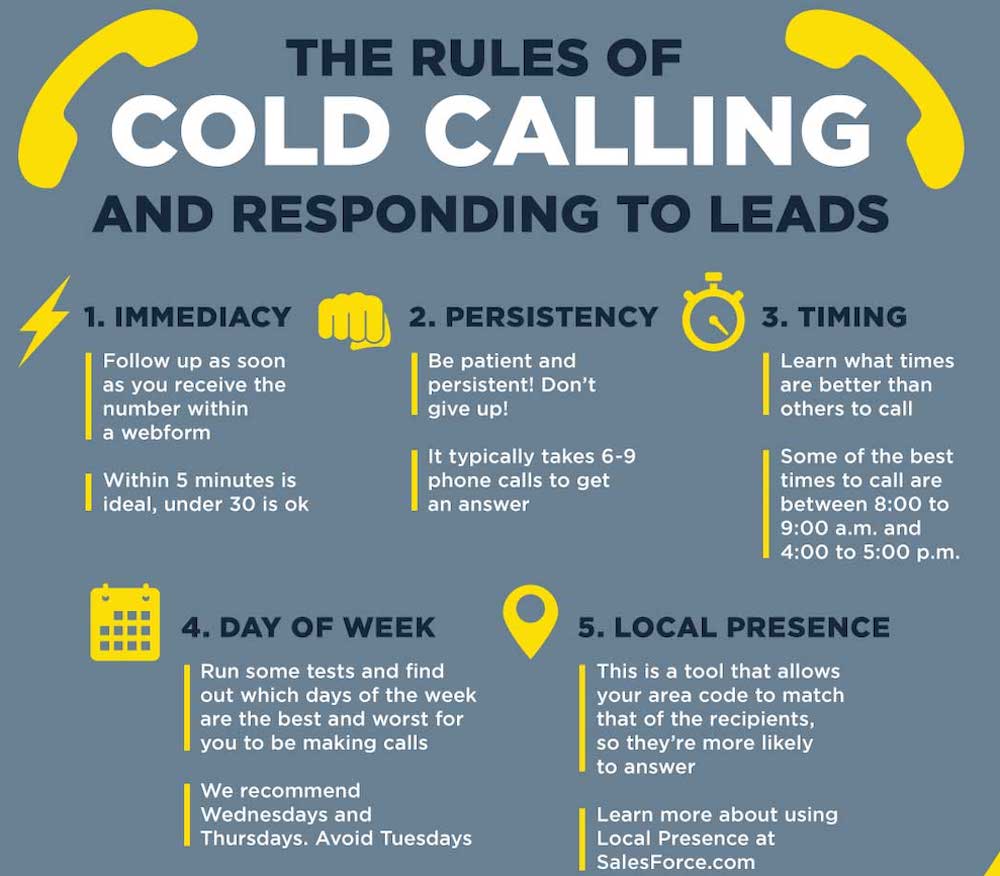
Source: www.getvoip.com
2. Ask Questions
Some people think sales is all about talking all the time. Instead, it is more about asking the right questions and listening carefully—at least at the beginning. When you’ve done your research, you can prepare helpful questions to ask your contact in order to make your pitch even more interesting which becomes helpful to convince your contact at a later point.
When it’s time to present your product in another call, it will immediately “shine more” or seem even more helpful, because you tailored your presentation exactly to what the other person or company is looking for.
3. Solution Selling
In the end, it’s all about whether your product or service help the company solve a nerve-wracking problem. Does it make someone’s life easier and more productive? People don’t want another fancy tool or shiny object to take care of. So, if you managed to present yourself both as supportive but also as an expert in what you do, the quality of your product will make the difference.
All in all, you sell companies solutions to help people, not products—keep that in mind next time when you call someone and ask yourself whether you’re doing the right thing.
Greetings from Your Marketing Team: Calling Hot Leads
In most DACH companies, you don’t just do cold-calling, but also contact companies that showed some interest in what you do. These are called “leads” and usually they are generated by everything your marketing department does—except maybe when you go to a trade fair, but that’s another topic.
You’ll encounter this type of sales activity more in modern, innovative companies than in traditional industries. But still, more and more companies know about the importance of lead generation and make us of it. There are many ways how to generate leads, but let’s have a look at the most popular ways:
1. Website/Blog
Perhaps the most known way to generate leads is to make the companies visiting your website “convert”, which means they download content that was “locked” before and which they obtained by typing in their personal information like their name, e-mail address and company name.
This happens with pricing lists, product demos, test accounts and much more. Some companies even have a blog on which they create content such as articles, but also whitepapers, success stories or e-books which other companies can download. Even more conversions!
On the other hand, there is also tracking software you can use to see who’s visiting your website and how they behave on it. This, of course, works mostly for people visiting your website from their office—only then you can recognize their company IP address. Sometimes, people just do research online and want to know more about what you do—but then they don’t send an actual request which can have many reasons! Maybe they don’t really have time for a meeting, they forgot about it, they don’t want to give away their data...This is where you come into play and contact them because you saw, that they visited and who knows? Maybe they need your solution more than they know
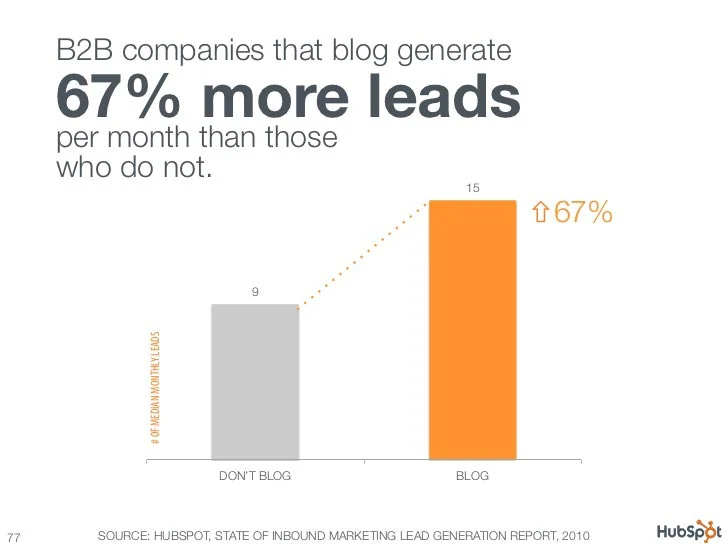
Source: www.neilpatel.com
2. Social Media
Apart from social selling—which we will cover later on—your marketing team can also be active on social media, like LinkedIn for instance, and generate leads with engaging content on the respective platform. You can further use utm-links in your posts to track, who booked a demo or visited your website from your social media post.
3. Webinars/Podcasts/Newsletters
Webinars or podcasts are also a great way to interact with your target audience and generate leads. The latter being a nice side product of the actual action. Let’s say you want to speak to sales reps and set up a webinar for cold-calling in e-commerce you can collect the email addresses of the attendees and see whether they are also interested in your product. Combined with a follow-up email (only with permission, of course!) or a subscription to your newsletter, companies will hear about you as often as possible and eventually convert.
The Trend: Social Selling
Social selling is THE thing in sales right now—in B2B in German-speaking countries as well. Social selling is selling but via social media.
On the one hand, it’s sales reps, content creators or marketing people delivering high-quality content on LinkedIn that will cause their target audience perceiving them as experts—which will result in prospects reaching out to them. On the other hand, there is a “cold” social selling version which is sales reps writing a private message to a relevant person from a target company to pitch their product or service.
The latter is, of course, quicker and less time-consuming than building a network, connecting and exchanging with people intensely. This is why we want to point out certain things which you will have to consider if you want to be successful at social selling:
1. Keep Your Profile Up-to-Date
An inaccurate profile with no profile picture won’t make you and your abilities look the best. That’s why you should invest some time in updating your profile adding all your skills, previous jobs, a personal description as well as a catchy profile headline. Scroll through your own LinkedIn feed—you’ll surely find some inspiration there.
2. Connect & Interact with People in Your Audience
LinkedIn is all about connections and “who knows who”—which can be really helpful to interact with your target audience. The more you active you are—by commenting, liking, posting and writing messages—the more interested employees from relevant companies will eventually stumble across your profile.
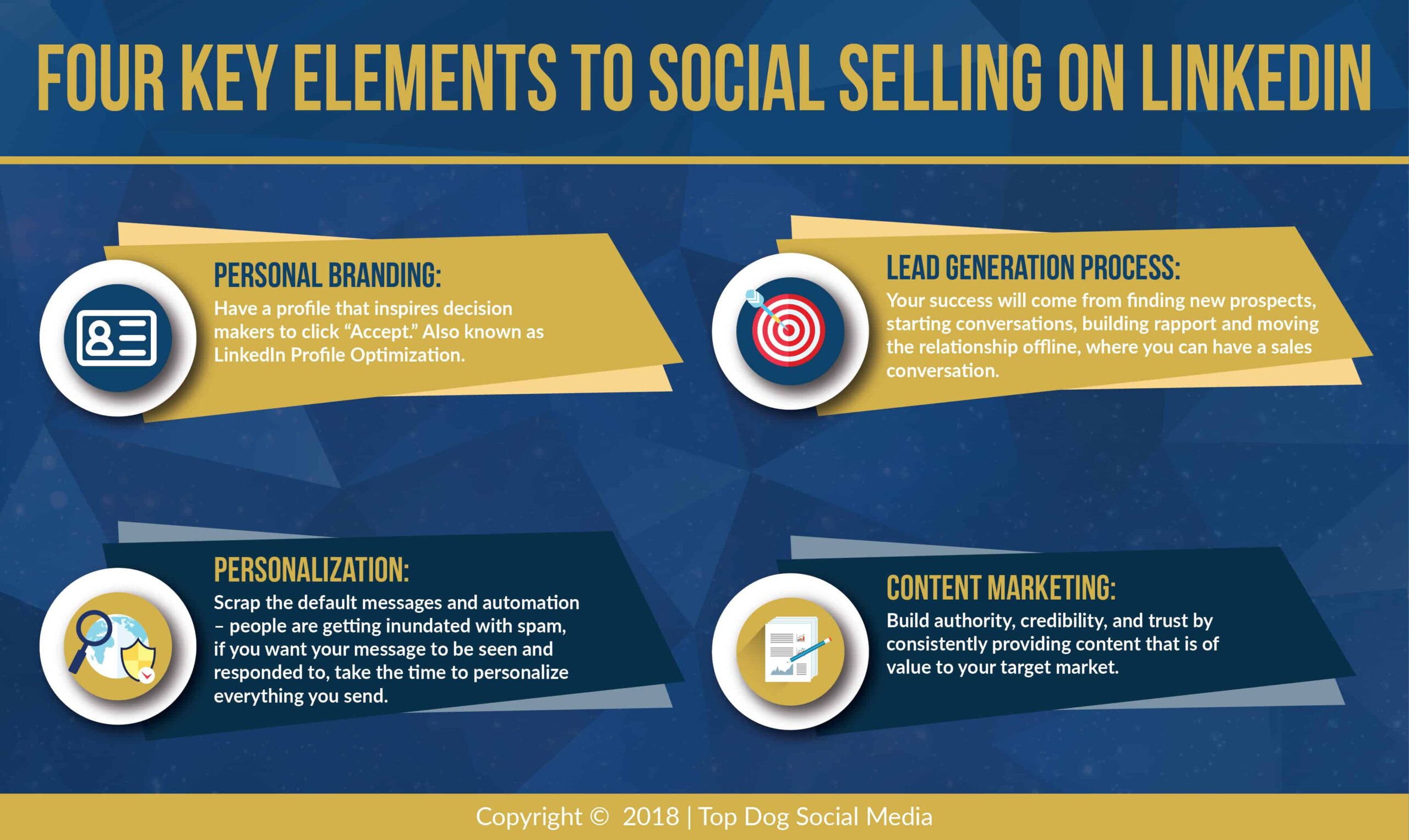
Source: www.socialmediatoday.com
3. Post Relevant Content Regularly
The trickiest part about social selling? Creating content yourself and post on a daily basis. Only in this way will the LinkedIn algorithm recognize you more and more, which will lead to a broader audience and an expansion of your status as an expert—given that you really provide your audience with highly relevant content.
4. Reach Out Only When Truly Relevant
A cold outreach on LinkedIn without any contact beforehand is just as hard as on the phone. The good thing is: On LinkedIn and social media you can interact with a person before you write to them directly. In most cases, people appreciate it more if you reach out to them after they’ve “known” you for some time on the platform. As always: Have a relevant solution and create an individualized pitch!
Old, but Gold: E-Mails / Mail
Have you ever thought about writing a good, old letter to your D-A-CH prospects? Okay, maybe you don’t want to write hundreds of letters yourself, but still, receiving offers (or maybe an invitation to an interesting networking event?) via mail comes across as very classic and therefore different.
Pro tip: The more individual your mail is, the more people will remember them and associate positive things with your product.
In German-speaking countries, people will probably find it quite creative of you and depending on the product even very convincing. Mail is still a valid form of advertising—but not very often used in the digital world of today. So, give it a try!
Pool of Leads: Trade Fairs
Yes, trade fairs are also a huge deal in German-speaking countries. Most of the companies that do B2B attend more than one trade fair every year (when there is no global pandemic, of course). So, it is very likely that you can meet your prospect from the DACH market at a specialist trade fair.
Trade fairs are not only very popular, they are also maybe the easiest way to generate leads and connect with interesting people and decision-makers. Companies attend trade fairs mainly for that reason, which means, you can just walk up to an interesting company from your target audience and talk to the people there—or book a meeting in advance. Trade fair visitors are usually more open about new solutions or helpful input, which is why you can pitch your product without further ado.
Since everyone is there for sales, they won’t mind you doing sales, too. However, we’ve still collected some tips for you to make your trade fair visit as successful as possible:
1. Define Your Goals in Advance
Ever got into a meeting without preparing in advance? Yeah. You know that’s never a good idea—and it’s the same with trade fairs. If you go there without setting your goals in advance and preparing your eventual meetings on site, you won’t be as successful. Period. Get together with your team and discuss how many leads you want to generate, with which company you want to talk and so on. Define you goals and be happy about your successes!
2. Get a Map & Plan Your Visits
Usually, you can get trade fair maps and a program in advance—which you should definitely use to plan you routes, your visits and maybe the most strategic places to have a coffee or get lunch.
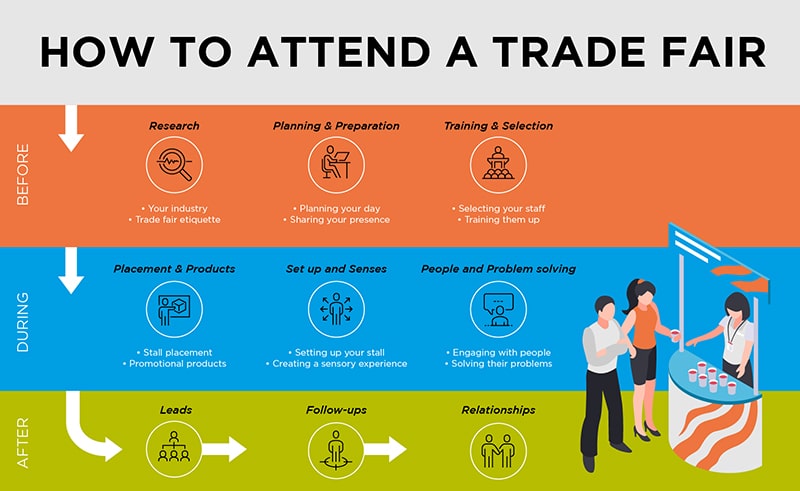
Source: www.magazine.adler.co.uk
3. Think About the Right Equipment
Going to a trade fair without banners, goodie bags or a camera is just not the same. On the other hand, matching outfits, snacks or funny gadgets that will draw attention to your trade fair booth are really nice. Thoughts about the right equipment for a trade fair visit are as important as plans for your goals!
4. Stay Spontaneous
We won’t contradict our own advice now, don’t worry. But a trade fair visit is often also a great opportunity to connect with people and companies in a more relaxed way. So, if someone invites you over to their booth to have a coffee and exchange, even though you were about to take pictures instead, you might want to consider changing your plans.
5. Postprocess Your Visit
The actual work starts after the trade fair. Now, you’ll have to analyze and discuss, what goals you achieved, who your leads are and most importantly, what your upcoming steps are for reaching out. Post-processing a trade fair means a precise strategy as well—and not calling companies randomly a few days afterwards.
Here are some important trade fairs in the DACH region:
Germany:
Name | Industry | Location | Visitors |
|---|---|---|---|
IAA | Automotive | Frankfurt | 1M |
Hannover-Messe | Industry | Hannover | approx. 800,000 |
bauma | Cunstruction Machinery | Munich | approx. 580,000 |
dmexco | Digital Marketing | Cologne | approx. 40,000 |
Essen Motor Show | Automotive | Essen | approx. 416,000 |
Internationale Funkausstellung | Mobile communications | Berlin | approx. 89,000 |
Switzerland:
Name | Industry | Location | Visitors |
|---|---|---|---|
BEA | Industry | Bern | approx. 300,000 |
Swissbau | Construction and real estate | Basel | approx. 100,000 |
Gevena International Motor Show | Automotive | Geneva | approx. 660,000 |
Inventions Geneva | Invention fair | Geneva | approx. 60,000 |
Olma Messe St. Gallen | Products & Services | St. Gallen | approx. 400,000 |
Austria:
Name | Industry | Location | Visitors |
|---|---|---|---|
Euromat | Innovation in Materials and Processes | Graz | no information |
Austropharm | Pharmacy | Vienna | no information |
Smart Automation Austria | Industry Automation | Linz | approx. 14,000 |
Renexpo Austria | Energy | Salzburg | no information |
Sales Force: On the Road to Success
As you might know, there are still some salespeople out there travelling from door to door on the search for a deal. In German-speaking countries that is a quite normal practice as well. In order to be successful on the road, we recommend the following:
1. Plan Routes in Advance
Don’t just hit the road and decide then. A successful sales force plans visits in advance to reach out to as many potential clients as possible. And: no one said, you need to plan alone! If you are part of a team, speak with them and plan which route makes the most sense and what kind of targets are located where together.
2. Stay in Touch with Your Colleagues
Being on the road can be quite lonely. But it doesn’t have to be! Stay in touch with your colleagues in the office to know whether there are some changes concerning your visits or maybe some other interesting opportunities. Obviously, they’ll help you stay motivated as well.
3. Use Your Time in the Car
Of course, you can also take your time on the road to relax and switch off your brain. This will give you energy for your visits! But you could also choose motivating podcasts—maybe from popular sales coaches? —and work on your mindset and skills while driving.
4. Choose the Right Apps
There are useful tools that can help you on your sales trip. For example, the Dealfront shows you companies and contacts in your surroundings, scans business cards and texts, synchronizes with your CRM and much more. This means less work for you after being on the road and the most efficient trip.
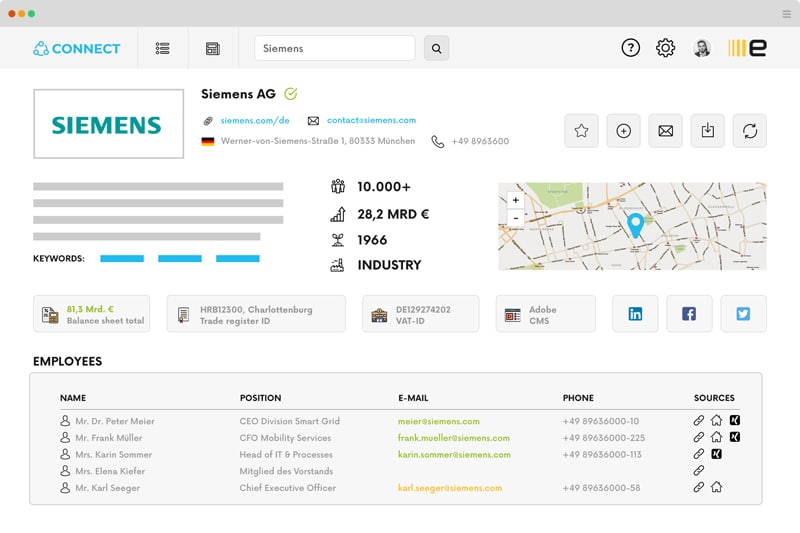
Source: www.dealfront.com
5. Analyze Your Visits
Postprocess your visits! It might be annoying to always analyze and discuss sales visits afterwards, but it is necessary for you to see where you’ve been most successful and where there is room to grow.
Summary: It’s all about Solution Selling
In conclusion, we can say that sales in German-speaking countries does not differ that much from sales elsewhere in the world, does it? If you got your cultural characteristic and preparation done in advance, there should not be a problem for you to win over prospects from the DACH region, too.
Think about which sales strategy fits you most and try to get to your future customers and every way possible! Trying different things (or trying them simultaneously) will help you double your successes, just try it!

